- Italy Tours Home
- Italy Ethos
- Tours 2023
- Blog
- Contact Us
- Dolomites
- Top 10 Dolomites
- Veneto
- Dolomites Geology
- Dolomiti Bellunesi
- Cortina
- Cadore
- Belluno
- Cansiglio
- Carso
- Carnia
- Sauris
- Friuli
- Trentino
- Ethnographic Museums
- Monte Baldo
- South Tyrol
- Alta Pusteria
- Dobbiaco
- Emilia-Romagna
- Aosta Valley
- Cinque Terre
- Portofino
- Northern Apennines
- Southern Apennines
- Italian Botanical Gardens
- Padua Botanical Garden
- Orchids of Italy
The Dolomiti Bellunesi: Magical Walks in Extensive
Wilderness at the Dolomites’ Fringes.
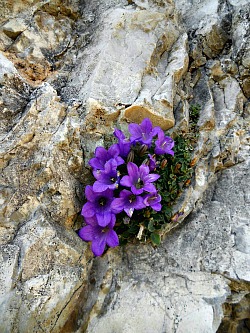
Geography
The Dolomiti Bellunesi National Park was created in 1990, but moved its first steps as far back as the 1960s (in the picture above, Campanula morettiana, a rare blossom chosen as the park's symbol).
Today the area protected by the National Park extends over 32,000 hectares, straddling the territories of 15 municipalities north of the central section of the Piave valley, the Val Belluna, where the two major centers of Belluno – the provincial capital – and Feltre lie.
Most parts of the park are wild and unvisited, and lie on the southernmost fringes of the Dolomites. Roads, here, rarely penetrate the higher grounds; paths are long and lonely, and if you venture in altitude, you will rarely find the crowds that denote – and sometimes plague – the Dolomites’ heartland.
The Dolomiti Bellunesi gather several important mountain groups, originally protected by individual reserves that were later joined together to form the National Park as we intend it today.
These groups are the Vette Feltrine, comprising the sub-groups of the Cimonega (2,547 m) and Pizzocco-Brendol (2,187 m); the Pizzòn-Monti del Sole (Mountains of the Sun, around 2,000 m); the Schiara (2,565 m)-Talvena (2,542 m; the closest group to Belluno), the Pramper (2,409 m)-Mezzodì (2,324 m; in the val Zoldana), and finally the Tamer (2,550 m)-Cime di San Sebastiano (2,488 m, in the Agordino area).
On the whole, it is a particularly remote area, and probably one of the very few patches of ‘real’ wilderness that can still be found in the North-east of Italy – even though it is less than two hours’ drive away from the hustle and bustle of Venice, and well connected to the surrounding main valley floors.
In fact, despite the name, it is worth repeating that the Dolomiti Bellunesi National Park is not actually located in the ‘heart’ of the Dolomites, but in a rather eccentric position, covering its most outlying ranges.
Precisely for this reason, though, the area has been well protected: being quite inhospitable, these mountains have always remained very sparsely populated, and many of its few inhabitants emigrated in the 19th century; hence, nature has always had pretty much the upper hand here. To this day, only 88 people inhabit within the perimeter of the protected area.
This is particularly interesting, because within the boundaries of the Dolomiti Bellunesi National Park there are a few small communities that have been almost completely abandoned, and so, on one level, these look today like ghost villages.
On the other hand, however, the Park has been actively involved in the restoration of many of the buildings, so that they can now be appreciated as examples of vernacular architecture (this is the case, for instance, of Gena Bassa and Gena Alta), which are both in the Valle del Mis (see below an image of the long lake that occupies the entire central scetion of the Mis valley).
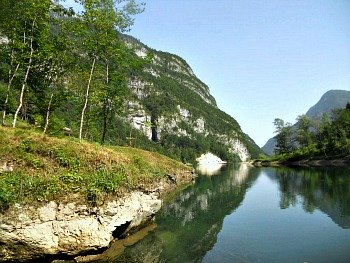
Geology
The park is also notable for its geology. The rocks are for the most part of sedimentary nature (calcareous or Dolomite), and therefore rich in fossils. Having said that, metamorphic rocks emerge occasionally (near the Valle Imperina, for instance), while the differences in subsoil affect both the forms of the landscape and the flora composition.
The Quaternary glaciations, also, have left an indelible mark. The same could be said for the karstic phenomena, which have created a complex system – especially so on the cave-riddled Piani Eterni (the Eternal Plains; see below).
In the eerie setting of the Busa delle Vette the two processes – the karstic
and the glacial – come together, and are both visible, making this a
unique spot in the whole park. This is also one of the most notable locations where to admire the local flora.
I have mixed feelings towards the more outlying fringes of the park, because even if the whole Dolomiti Bellunesi National Park is undoubtedly very beautiful and mostly wild, some sections of it have been turned almost into playgrounds – perhaps with the conscious intention, on the side of the park's administration, of leaving exposed to the general public the areas that are most easily accessible and less vulnerable.
This is what happened, for instance, in the Valle del Mis and, to a lesser extent, in the Val Canzoi, while the conservation efforts have not been spared – and are concentrated – on the higher section of the park, in those areas that will only be reached by dedicated walkers, and by a type of public – generally speaking – more aware of the needs of conservation and of protecting a fragile environment.
Given the topography of the area, then, on the whole this makes sense: there are quite a few jewels contained within the Dolomiti Bellunesi National Park, but the rewards you can reap from them will have to be hard-earned. It is a fact, for instance, that one of the main reasons for establishing the park in the first place is the beauty and uniqueness of its flora.
A Floral Haven
This richness is something that was acknowledged as far back as the 18th century, when especially the area of the Vette Feltrine – but also of Monte Serva (2,132 m), near Belluno – were already well trodden grounds, roamed by famous and lesser-known botanists alike for their floral variety.
The park is still well endowed with flora and hosts more than 1,300 plant species (but the figure raises to 1,750 when considering also the adjacent valley floors) amounting, all in all, to about one fourth of the flora of Italy!
Amongst them, some very rare specimens thrive, such as Iris cengialtii – an endemic to North-east Italy (namely, Monte Cengio). The Campanula
morettiana was chosen as the park’s symbol for its rare beauty (it is pictured at the top of the page), while Corthusa
mattioli – a small plant belonging to the Saxifragaceae family, with
delicate purple flowers – is also quite a rare sight. Equally rare to see are the splendid blue panicles of Delphinum dubium (pictured below), which can be admired in a restricted area of the Busa delle Vette – undoubtedly the botanical hotspot within the Vette Feltrine.
Other species are either disjoined or at the margins of their usual area of distribution – as is the case, for instance, of Alyssum ovirense, which comes from the Balkan Peninsula and finds in the Vette Feltrine its westernmost location.
In the park were also discovered for the first time important plant communities – especially those thriving on rock walls, detritus and nival valleys (a technical term to designate narrow side valleys where the snow lingers for a long time).
Some species – such as Minuartia graminifolia, Rhizobotrya alpina and Thlaspi minimum – find in the botanical haven of the Vette Feltrine their “locus classicus” (which means that this is the place where they were first discovered). But to reach these plantsman’s paradises you will have to walk – no alternatives! It can be quite a pleasurable ‘price’ to pay, however, given the beauty of the scenery – but it is an unavoidable fact that the ascents are generally long and steep.
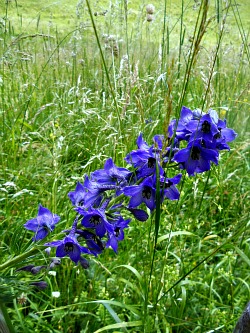
Notable Areas Within the Park
Some areas of the Park that are famous for their solitary beauty often owe their name to this unique status – such as in the case of the Piani Eterni (Eternal Plains). This is a solitary, undulated plateau at about 2,000 metres of altitude, peppered with interglacial lakes, while the Monti del Sole (the Mountains of the Sun) are at the core of the wildest area.
The ‘Monti del Sole’ are a craggy, arid, inhospitable rock environment – but sublime nonetheless: a term which is meant here as it was originally intended in the Romantic age, to signal a landscape which is awe-inspiring (rather than simply ‘beautiful’).
Other notable areas, included in the Vette Feltrine, gather around Monte Pavione (2,334 metres) – a mountain range interspersed with limestone wastes and glacial cirques (or ‘buse’) – and Monte Pizzocco (2,187 m), whose Matterhorn-like peak towers above the cave-riddled Piani Eterni.
‘Pendane’ and ‘malghe’ – former dairies and animal shelters that the park has often contributed funds to restore – are often the only buildings you are likely to find, if you are going to venture in altitude. Sometimes, these buildings have been brought back to their original use as working facilities, while at other times they were reconverted as huts and refuges for stranded walkers.
Amongst the working ones, one can list Malga Vette Grandi (1,865 m), in the karstic setting of the Busa delle Meraviglie (the Marvel’s Hole) Malga Erera and Malga Brendol (1,708 m), in the Piani Eterni. On the Zoldo side, Malga Pramper (1,540 m) is in the homonymous valley; Malga Pian dei Fioch (1,739 m) is on Mt. Serva and, lastly, Casera dei Boschi (1,253 m) is above Passo Croce d’Aune (1,011 m) – this latter location reachable also by car.
In fact, the park has often received awards for these restoration projects, as they make a wise use of traditional building materials and techniques, as well as harnessing sources of renewable energy. With the goal of contributing good educational facilities in mind (which is part of the mission of a National Park) – but at the same time of providing basic but high-standard accommodation for those walking in altitude – these projects ultimately set the example by using tools and techniques that hopefully can be applied to other similar situations, not only within the Park (“benefits beyond boundaries”, after all, is the slogan of the Dolomiti Bellunesi National Park).
To the north and east, the park straddles into the Agordino and Zoldano sub-regions – on what is ‘proper’ Dolomitic terrain. Here, the landscape changes into the more familiar Alpine view of majestic spruce forests, topped by the lunar peaks of the Dolomites.
But there are also some other areas notable for a more unusual tree cover – for example the Austrian Black Pine (Pinus nigra) woodland formations, which find in the Valle del Mis their westernmost location (these are species of Illyrian-Balkanic – and therefore mostly eastern – distribution).
But even around the edges of the Dolomiti Bellunesi National Park there are areas that are very little frequented by the average walker – hidden jewels that will be particularly cherished by those desiring to walk in solitude, and to enjoy an unspoiled wilderness: amongst these, worth mentioning are the Val Tovanella, the Val Montina, and certainly – further to the east, beyond the Piave valley – the Dolomiti Friulane.
The Val del Grisol (Grisol Valley)
An ancient forest, rich in treasure troves and filled with rare wonderful creatures: we are not talking about Harry Potter’s Forbidden Forest, though. This is the Val del Grisol forest — one of a kind in Europe for its many types of trees: an ancient and extraordinary forest, just like the “Old Woods” told of by Dino Buzzati in his stories.
The Val del Grisol originated from the confluence of a number of small valleys furrowing the eastern slopes of the Schiara-Talvena group (Val dei Ross, Val Costa dei Nass, Val Grave di San Marco); it is an isolated and solitary valley, dug into Jurassic marine sedimentary rocks (flinty Dolomite rocks; marls and limestone). Steep slopes and high rocky drops characterize the outcropping areas of the compact formations, while gentler slopes can be found only on the degradable marly formations.
Among the most notable valleys of the Park, the Val del Grisol differs from the others for the distinctive features of its wet, cool and shadowy ravine environments, and for the quality of its Silver Fir (Abies alba) and Beech woodlands (Fagus sylvatica). Silver Fir dominates between 600 and 1,100 meters of altitude, where it is particularly luxuriant and associated in a characteristic way with the so-called ‘noble’ broadleaved tree species such as Common Ash (Fraxinus excelsior), Sycamore Maple (Acer pseudoplatanus), Norway Maple (Acer platanoides), Wych Elm (Ulmus glabra) and Small-leaved Lime (Tilia cordata).
Among the most interesting floral species, Spindle (Euonymus latifolius) and Honesty (Lunaria rediviva) are worth a mention. This forest has exceptional features, and it is unique for its type in Europe; moreover, the Silver Fir woodlands of the Val del Grisol are one of the most extraordinarily rich wildlife habitats of the Park, displaying bird species such as Northern Goshawk (Accipiter gentilis), Hazel Grouse (Tetrastes bonasia), Black Grouse (Tetrao tetrix), Tengmalm’s Owl (Aegolius funereus), Black Woodpecker (Dryocopus martius), European Pine Marten (Martes martes), plus — among the mammals — Red Deer (Cervus elaphus) and Roe Deer (Capreolus capreolus).
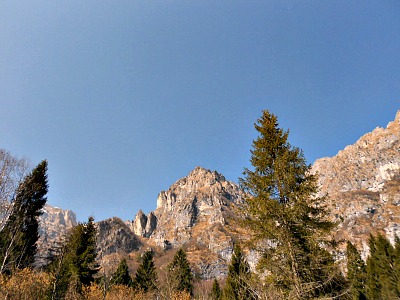
Alpine Huts Within the Park
Although the surface of the park is quite extensive, it is dotted with six Rifugi (mountain huts) that can be used as a base for zigzagging the area in altitude.
Even though mention of them will also be made on the individual pages describing the specific area where they are located, these are: Rifugio Dal Piaz (1,993 m), on the Vette Feltrine – the westernmost of the park, making it the obvious base from which to explore the botanical haven of the Busa delle Vette.
The ascent to the green pyramid of Monte Pavione (2,334 m) is another spectacular excursion that can be started from here, but the possibilities for circular trails – sometimes very demanding – are endless, straddling the nearby valleys of Aune, Val di Lamen (whose craggy mountains are pictured above), Valle di San Martino and val Canzoi (of which is portrayed an image below).
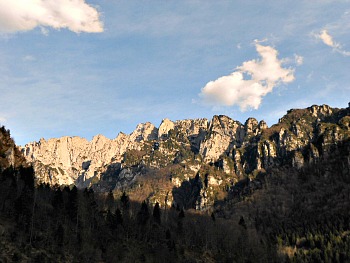
Rifugio Boz (1,718 m) is the base for the ascent to the Cimonega sub-group (2,547 m); it can be accessed either from the Trentino side or from the Val Canzoi.
From here there is also the possibility of joining the Alpine Highway No. 2 (Alta Via n. 2, delle Leggende – of the Legends) towards the Bivacco Feltre-Walter Bodo – a bivouac on the Pian della Regina.
Rifugio Bianchet (1,245 m) is in the Val Vescovà, and even though it is the one at the lowest altitude, it is nonetheless immersed in a deep woodland setting, between the Schiara group (2,565 m) to the north and the Talvena (2,542 m) to the south.
It can be accessed via a steep path from the val Cordevole valley floor, not far from the Valle Imperina disused mines, now a visitor’s centre and a hostel.
The Rifugio VII Alpini (1,502 m), also on the southern slopes of the Schiara (2,565 m), can be reached from Belluno via the short, steep and wild Valle dell’Ardo, rich in historical and natural highlights.
This hut is usually very crowded in the summer months, when it is used as a base for demanding treks in altitude along the Alpine Highway No. 1 (Alta Via n. 1, Dolomitica).
Rifugio Pian de Fontana (1,632 m) is located in the higher reaches of the Valle dei Ross, and it can be accessed from the lower Valle del Maè, crossing a magnificent forest along the way and through the Forra del Grisol (Grisol gorge; described above), which can be entered from Longarone and the Zoldano.
This is an important base for excursions on the Talvena group (2,542 m), and it is just over two hours’ walk away from Rifugio Bianchet through the Forcella La Vareta (pass), in an area of high natural and historical relevance.
Lastly, Rifugio Pramperèt (1,758 m) is located on the meadows of Prà della Vedova, and is reached through the Val Pramper, in the Zoldano sub-region.
It is surrounded by a scenario of high, majestic Dolomite peaks, and immersed in a setting of verdant meadows, crawling Dwarf Mountain pine patches and scree habitats that host the most interesting Alpine flora.
Needless to say, the whole area is zigzagged in all directions by an extensive network of well-marked paths and itineraries (generally using the standard CAI – Italian Alpine Club – sign, a red-and-white striped marker; the park’s signs, instead, are purple-and-yellow, and that can sometimes lead to confusion, so be warned) that allow for more or less demanding links with most other areas of the Dolomites.
Even though very sparsely inhabited, the territory of the Dolomiti Bellunesi National Park is also interspersed with numerous traces of human activity, which over the centuries has affected the so-called “Terre Alte” (literally, Highlands).
These often minute but important signs have been painstakingly studied, and work on them is coordinated by one of the most notable cultural institutions in the province of Belluno, the Museo Etnografico della Provincia di Belluno, with the help of other minor museums and institutions (such as the “Museo del Chiodo” – the Nail’s museum – in Zoldo).
Important archaeological finds also bear witness to the fact that – even though seemingly devoid of relevant human presence today – these areas have historically been roamed and exploited by man since Pre-historic times (see below an image of the Covoli – rock shelters used by Pre-historic populations, which today are very important archaeological sites – in the Val di Lamen).
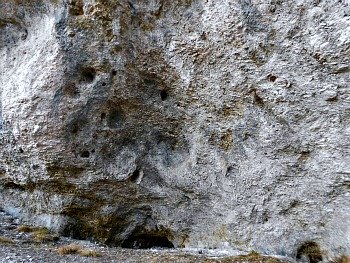
However, my most precious advice – if you plan to visit the area – is not to limit yourself to its most outlying fringes, like the valley and lake of Mis (Valle del Mis) and the Val Canzoi.
Not that these areas are completely devoid of interest – all the contrary, in fact – but they are certainly the most crowded, and would provide only a tiny taster of what the magnificent Dolomiti Bellunesi have in store for you!
Having said that, wherever you plan to go, the Dolomiti Bellunesi National Park will not let you down: if you’re prepared to make the effort, and venture inside its remotest (which are often the highest) parts, you’ll be amazed to discover wild nature, beautiful rare plants and amazing views that are equally breathtaking as those you would find in the more familiar Dolomites’ heartland.
Return from Dolomiti Bellunesi National Park to Italy-Tours-in-Nature
Copyright © 2019 Italy-Tours-in-Nature

New! Comments
Have your say about what you just read! Leave me a comment in the box below.